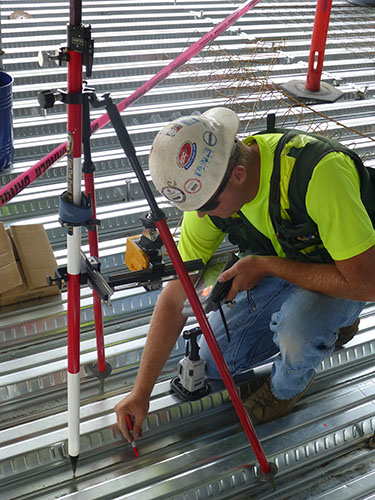|
Subscribe / Renew |
|
|
Contact Us |
|
| ► Subscribe to our Free Weekly Newsletter | |
| home | Welcome, sign in or click here to subscribe. | login |
Architecture & Engineering
| |
 |
October 29, 2015
A step-by-step guide to selecting a virtual design partner
Lease Crutcher Lewis

Gouchenauer
|
Getting the most from building information modeling/virtual design and construction (BIM/VDC) is like learning anything — be it playing guitar or baking bread. We can read, watch videos and try things, but it isn’t until we find the right partner to help us through the process that we can attain the best outcome.
Having knowledgeable and experienced partners is the key to every success. For example, when owners are interviewing contractors they often ask “Do you use BIM?” Most design and construction firms do, but do they use it efficiently and partner effectively with the rest of the team to realize the full value of the technology?
Here are some things to watch for:
Ask pointed questions. How does your prospective partner use modeling software? What limitations have they seen and what makes their process more efficient and lean than others? What new ideas do they bring? Can they document how they use the model to interface with all project team members?
You may have questions about BIM/VDC processes or whether something you saw is even possible, so ask! In any good partnership it’s important to feel comfortable asking questions and feel comfortable with the answers. Probing questions are the means to getting there.
Check references. During any selection process, checking references is standard.
Ask if the BIM/VDC examples show how modeling was used and if it produced savings. For example, with early modeling and coordination with the design team on a recent job we isolated a problem with the shoring. Further exploration showed that the initial concept and certain proposed solutions were not possible due to the site.
The full picture with the model facilitated team collaboration and a holistic solution. The old way was to find the problem in the field, stop work, issue an RFI with a suggested solution, and then finalize the decision. Work stoppages cost money and time, and require rethinking work sequences and safety plans. Solving the issue at the modeling stage saves time and money. We estimated the cost savings in this case to be $10,000 in hard dollars and much more in indirect expenses.
Pretty picture or working model. A beautiful picture can make great impression, but the real question is “Is the model an actual money-saving end product?” Will that basic model gain detail and become the basis of buyout and construction, informing installers so the finished product is installed properly, safely and efficiently? Does it address the phasing or how the site is going to be used? Are potential issues identified that might have been missed with the traditional 2D method? Is the model used to help with the construction budget and to inform both clarifications and omissions?
All of these tasks are made more robust and clear, and build confidence in the team.
Identify the barriers. With VDC there are often challenges with existing contract language limiting the ability of firms to work seamlessly together. The industry is at best finding piecemeal workarounds. It is invaluable to find a partner that will help create a collaborative environment, where the project’s overall success and helping each other succeed are primary.
Think small and large. Smaller projects have been slower to adopt BIM/VDC. The impression may be that there is little return on investment, but that is incorrect. In one example, a VDC coordinator was so efficient that not only were the building’s work packages completed before demolition of the existing structure, but he coordinated the mechanicals with the steel fabrication company before that juncture as well, noting where the penetrations would be required.
The contractor then fabricated the steel with more than 75 penetrations at its shop. This meant no workers hanging from steel onsite to drill them, a safety improvement and time saver.
The $20,000 contingency for steel was not used, a significant savings to the owner. Once the building was modeled and work packages issued, the VDC coordinator moved on to the next project, saving more money.
Resolving issues early
Using VDC allows issues to be resolved early. With preconstruction views of projects we can find cost savings prior to beginning work, coordinate with all trades and sequence work so that there is no conflict, facilitate on-time material delivery and maintain up-to-the date information that allow project team members to be nimble, and avoid having to perform rework. The value is as much in making for a safer workplace as it is in measurable dollars.
The “we’ve done it that way for years” mindset is obstructionist and precludes trying new methods that have the potential for enormous payoffs. Yes, it is disruptive to old thinking and processes, but just like learning any new skill, after you have teamed with a professional the process is no longer disruptive — it is just the way to do business effectively.
Lana H. Gochenauer, LEED AP BD+C, is VDC manager and has been with Lease Crutcher Lewis since 2011. She is heavily involved in preconstruction and the standardization of the VDC process. She also is vice president of Seattle Revit Users Group.
Other Stories:
- Architects are the QB; meet the rest of the team
- Survey: Freiheit & Ho Architects
- Survey: Weber Thompson
- Survey: BCE Engineers
- Survey: NAC Architecture
- Survey: ESM Consulting Engineers
- Survey: Davido Consulting Group
- Survey: Studio 19 Architects
- Installing an AV system? Try your IT network
- Dramatic tax change is good for in-state A&E firms
- A closer look at Seattle’s new NBA/NHL arena
- Seattle Pacific University retro-commissions 25 buildings
- What is Seattle's hot new neighborhood? LoSto
- Group polishes guidelines for design-build projects
- Survey: Karen Kiest Landscape Architects



